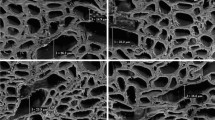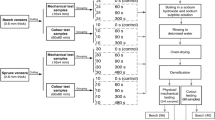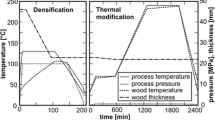Abstract
The study investigated the effects of short-term thermo-mechanical (STTM) densification temperature and pressure on changes in surface wettability of veneer of different wood species (alder, beech, birch and pine). Veneer sheets were densified using pressure levels of 4, 8 and 12 MPa at three temperatures: 100, 150 and 200 °C for a short time of 4 min. The wettability analysis showed that in a relatively short process time wettability can be changed significantly; STTM-densified veneer surfaces became more hydrophobic.
Similar content being viewed by others
Avoid common mistakes on your manuscript.
1 Introduction
In recent years thermo-mechanical (Arruda and Del Menezzi 2013; Bekhta et al. 2012) or thermo-hydro-mechanical processing (Diouf et al. 2011; Navi and Sandberg 2012) of wood has been used to improve some of its less favorable characteristics. However, this treatment causes changes in surface properties of wood, in particular the surface becomes hydrophobic, which can cause serious problems (even more complicated) when gluing or coating. Based on this fact, low contact angles are more important for efficient wettability and adhesion.
In literature on the subject there is sufficient information on the influence of different treatments on changes in wettability of wood and wood-based materials. However, most of these studies were performed on solid wood samples during long-term treatment (Navi and Sandberg 2012). Nevertheless, not much is known about wettability of wood/veneers densified for a short time. Therefore, the objective of the present study was to characterize the effects of STTM densification temperature and pressure on wettability of wood veneers of various wood species.
2 Materials and methods
Rotary-peeled alder (Alnus glutinosa Goertn.), beech (Fagus sylvatica L.), birch (Betula verrucosa Ehrh.) and pine (Pinus sylvestris L.) wood veneers with 1.5 mm nominal thickness and ~5 % moisture were used in this study. Each veneer specimen was STTM densified between smooth and carefully cleaned heated plates of an open-system laboratory press at temperatures of 100, 150 or 200 °C and pressures of 4, 8 or 12 MPa for a short time of 4 min.
Static contact angles of each non-densified and densified sample were measured using the sessile drop method. For each sample five drops of 3.5 μl distilled water were deposited manually by means of a chromatographic syringe on the wood tangential surface. The contact angle was measured using a microscope equipped with a goniometric head so that the hairline passed through the point of contact between the drop and veneer surface and tangentially to the drop at that location. Measurements were made 5 s after distilled water had been dropped on the sample surface. To study the potential ageing of densified surfaces static contact angle measurements were also performed at 1, 4 and 24 h after densification. Not less than five measurements were taken to reduce uncertainty in the measured contact angles due to structural and chemical variations of the wood samples.
3 Results and discussion
3.1 Non-densified veneer
There is a significant difference in the values of the contact angle between the investigated wood species (Fig. 1). This may be attributed to different surface chemistry of each species, different surface roughness and anatomical (morphological) surface structure. The surface of pine was more hydrophobic than that of the other wood species investigated, as indicated by the contact angle being significantly higher for pine samples (54.19) compared with alder (28.13), beech (24.59) and birch veneer (45.34) samples. This result was expected because in comparison to those other wood species (with 0.8–3.8 %) pine wood contains a higher amount (4.4–5.6 %) of extractives (Fengel and Wegener 1989), many of which migrate to the surface during veneer drying. Moreover, pine wood contains more lignin (27.2 %) than the other wood species (19.4–23.9) (Fengel and Wegener 1989), which could also contribute to the lower wettability of pine wood surfaces.
3.2 Densified veneer
As expected, the contact angle values of all veneer samples were higher than those of untreated veneer samples (Fig. 1). The general trend is that the contact angles of the water drop increased with increasing densification temperature (except for the temperature of 100 °C) and pressure. The ANOVA results revealed that temperature has a more significant effect on the contact angle than pressure; higher temperature leads to a higher contact angle, i.e. worse wetting, for all investigated species. These results are in good agreement with data obtained in earlier study (Diouf et al. 2011).
The highest contact angle was recorded for the surface exposed to 200 °C. In particular, the maximum increase in the contact angle with the temperature increasing to 200 °C was 179.8 % for alder, 158.7 % for beech and 63.3 % for birch, respectively. Under similar conditions the increase of the contact angle for pine was only 17.5 %. The results are somewhat surprising, as pine had lower values of the contact angle than the other investigated wood species for the highest temperature of 200 °C and densification pressure of 12 MPa, having a higher content of extractives and lignin. Obviously, it may be assumed that the content of extractives is not a significant factor that influences wettability. Hardwoods have substantially higher contents of hemicelluloses in comparison with softwoods, and hemicelluloses are one of the factors that also have an effect on wettability. Wettability decreases due to chemical changes, such as degradation of the most hygroscopic components of wood (hemicelluloses, lignin and cellulose) (Kocaefe et al. 2008).
The ANOVA results also showed that the duration of exposure of densified veneer samples does not affect the contact angle of the veneer. Examination of the contact angle decay curves for a 24 h period confirmed that the effect of the densification treatment was stable for at least 24 h in the case of the hardwood and softwood veneer samples (Fig. 2).
4 Conclusion
The wettability analysis showed that STTM-densified veneer surfaces became more hydrophobic for all of the wood species investigated at temperatures between 150 and 200 °C. The effect of temperature on the contact angle was more evident than that of pressure. The differences in the contact angle between all the four wood species were statistically significant. The wood species were ranked by contact angle from highest to lowest: pine, birch, alder and beech. The data generated in this study may be used as initial information for further processes such as finishing or gluing of veneer from the four wood species.
References
Arruda L, Del Menezzi CHS (2013) Effect of thermomechanical treatment on physical properties of wood veneers. Int Wood Prod J 4(4):217–224
Bekhta PA, Niemz P, Sedliacik J (2012) Effect of pre-pressing of veneer on the glueability and properties of veneer-based products. Eur J Wood Prod 70(1):99–106
Diouf PN, Stevanovic T, Cloutier A, Fang C-H, Blanchet P, Koubaa A, Mariotti N (2011) Effects of thermo-hygro-mechanical densification on the surface characteristics of trembling aspen and hybrid poplar wood veneers. Appl Sur Sci 257:3558–3564
Fengel D, Wegener G (1989) Wood: chemistry, ultrastructure, reactions. Walter de Gruyter, Berlin
Kocaefe D, Poncsak S, Doré G, Younsi R (2008) Effect of heat treatment on the wettability of white ash and soft maple by water. Holz Roh-Werkst 66:355–361
Navi P, Sandberg D (2012) Thermo-hydro-mechanical wood processing. EPFL Press, Lausanne
Acknowledgments
The authors would like to thank the COST Action FP 1006 “Bringing new functions to wood through surface modification” for financial support within the framework of the Short Term Scientific Mission (STSM).
Author information
Authors and Affiliations
Corresponding author
Rights and permissions
About this article
Cite this article
Bekhta, P., Proszyk, S., Krystofiak, T. et al. Surface wettability of short-term thermo-mechanically densified wood veneers. Eur. J. Wood Prod. 73, 415–417 (2015). https://doi.org/10.1007/s00107-015-0902-4
Received:
Published:
Issue Date:
DOI: https://doi.org/10.1007/s00107-015-0902-4






